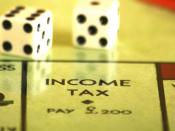The facts of this case were that the taxpayer (and three others in partnership) entered a complex scheme, which involved the partnership, and annuity and loan arrangements. The scheme was financed through a series of "round robin" cheques and promised substantial deductions in the first five years of the 15-year plan. A number of documents were exchanged but no cash payments were made. This was calculated to return neutral cash flows with high tax deductions initially and high assessable income, especially in the last five years. A feature of the scheme was that there was an opportunity to terminate it in the last five years. In the relevant year the partnership derived assessable income of $170,000 and claimed deductions of $360,000.
The issue before the court was whether the taxpayers were entitled to a deduction for interest. A lot of matters were argued before the case reached the High Court but before the Full Court the Commissioner's contention was that the interest deduction should apportioned and disallowed under s 51(1) to the extent that it exceeded the partnership income.
Their Honours indicated that if a taxpayer's costs in deriving income were less than the actual income, the deductions would be allowable. However, if the costs exceed the income derived, the taxpayer's purpose for making the expenditure may be relevant in characterizing and apportioning the expenditure for the purpose of the general deduction provision. This may include the taxpayer's purpose for incurring the expenditure. Manson CJ, Brennan, Deane, Dawson, Toohey, Gaudron and McHugh JJ said (at ATR 622-3): "...The position may, however, well be different in the case where no relevant assessable income can be identified or where the relevant assessable income is less than the amount of the outgoing...the disproportion between outgoing and income, the whole outgoing is properly to...



Sugestion
You shouldn't jump right in, you need more of an intro.
0 out of 0 people found this comment useful.